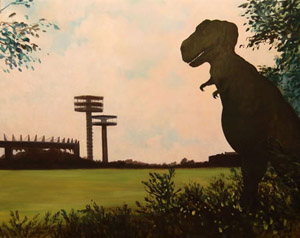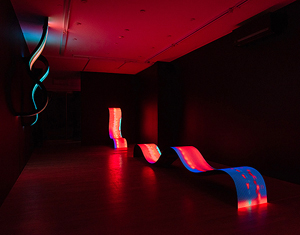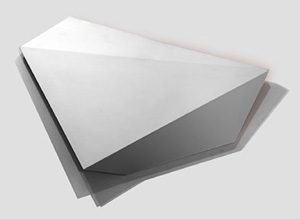No Apologies (Virtually)
John Haberin New York City
Covid-19, Shuttered Galleries, and Online Exhibitions
No apologies. Artists can take advantage of social isolation during Covid-19 to do what they were going to do anyway, gladly so, in the studio. Shuttered galleries and museums can go online. Should you as well, and can it make up for lost sales and all that you have missed? Maybe love means never having to say you're sorry, especially if you love art, but I have my doubts.
Collections before exhibitions
They may be short on apologies, but they sure have no end of euphemisms. They can still have their regularly scheduled exhibitions, only "virtual exhibitions." Their evening openings can still take place, only without you. Web sites become "virtual tours," "learning opportunities," or "viewing rooms."  On-screen images become an "offline exclusive." One can only long for a healthy dose of (real or virtual) reality.
On-screen images become an "offline exclusive." One can only long for a healthy dose of (real or virtual) reality.
Even if your bs meter has long since gone off, you may have better things to worry about, I know. Who is not chained to a device or two these days? I have walked by empty galleries countless times now, just as I did when they shut their doors for Hurricane Sandy, but not out of nostalgia. With my gym closed, too, I just need the exercise. More than one has already announced its closing for good, and that includes the gallery that supplied the image of disaster (by Deborah Brown) that you see here. Virtual reality (or "augmented reality" for Nancy Baker Cahill) is all well and good, but the financial realities of the lockdown are just plain scary—and I look more closely at Covid New York, art after Covid-19, galleries after Covid-19, and claims for the death of art fairs elsewhere.
Virtual exhibitions, then, could be the least of our problems, but has anything really changed? Not much, as it happens, and that may not speak well for the potential of art online. One might expect the most from museums, with their huge staffs, give or take major layoffs, and deep pockets. By the same token, though, their Web sites are and claims for art therapy mostly old news. Most have long had digitized collections that you can search by artist, while exhibition Web sites lag considerably. I still feel grateful as a writer for not just press previews, but also press kits for, with a little luck, the correct spelling of proper names and an exhibition checklist.
Not surprisingly, then, the best results come from institutions that are, first and foremost, unchanging collections. The Barnes Foundation has punched up its Web site, so that it feels closer to exploring—a nice addition given its all too controlling founder. The Frick Collection, which led the way to the digital collection in the first place, has weekly "cocktails" with curators. Just be sure to bring your own booze. Any museum interface, though, is at best a matter of taste, at least still another excuse.
Museums, of course, are also event spaces and gathering places for hundreds, which is precisely why they have had to close. And that, too, presents opportunities. A performance at the Met of The Mother of Us All, the opera by Virgil Thompson and Gertrude Stein, no longer required tickets or even a set viewing time. Speaking only for myself, Thompson's arty diction and tonality does not sit well with Stein's playfulness and passion, and the taping is straightforward and static, but it is still welcome. If anything has changed for good from the pandemic, I hope that it will include more of the same. As a side benefit, a need for greater online access to exhibitions and events could give new urgency to undoing some of the layoffs.
Galleries can boast of far less, but they also do a lot more boasting, and who would blame them? Such is business. Still, those virtual exhibitions look awfully like the pages that were there all long. All but the most marginal of galleries have them, and the few that do not regularly update them were an annoyance well before the virus. (Dealers, you know who you are.) Someone like me who spends hours tracking Web sites on top of email lists and gallery guides to plan for upcoming exhibitions knows them well—but with hardly a glance at any one.
Same old new media
Gallery exhibition sites remain spare, with as little as a paragraph and a single image, and why not? Shuttered galleries may not have hung the work in the first place. Every so often, a site gets creative, like Jack Shainman, which breaks up a plenitude of images by Odili Donald Odita with free-form meditations by the artist. More often, though, the emphasis merely shifts from current exhibitions to gallery artists—often in a corner of the site not so easy to locate without help from an email. That can take the novel form of a featured new work each day, as with Sargent's Daughters, or, as with Josée Bienvenu, virtual "studio quarantine" visits. Still, there is no getting around the feeling of same old, same old.
 For some galleries, though, same old was always new—like those with an emphasis on new media. Bitforms, long devoted to interactive art, may still struggle to bring Daniel Canogar and others to the Internet, although an interactive time line curated by Claudia Hart would be dizzying enough its pace alone. Signs and Symbols, which often roots the art object in performance, as with Annabel Daou, may lose something when the performance is no longer live, although Fridman gallery is confident enough to be selling tickets. If nothing else, one has to sit through the video at one's monitor, and that can feel like work. Still, they are teasers for a more lively future, and the future may not be so very far off. It just may not have much room for painting and sculpture.
For some galleries, though, same old was always new—like those with an emphasis on new media. Bitforms, long devoted to interactive art, may still struggle to bring Daniel Canogar and others to the Internet, although an interactive time line curated by Claudia Hart would be dizzying enough its pace alone. Signs and Symbols, which often roots the art object in performance, as with Annabel Daou, may lose something when the performance is no longer live, although Fridman gallery is confident enough to be selling tickets. If nothing else, one has to sit through the video at one's monitor, and that can feel like work. Still, they are teasers for a more lively future, and the future may not be so very far off. It just may not have much room for painting and sculpture.
Call these antisocial media. Martos has Friday screenings and 601Artspace four-day runs of single videos, one more provocative than the next, while at Carriage Trade more than two hours of short films by Dan Graham and others project the "Public Images" of urban and suburban America. With her 2014 Traveling Shots, Diane Nerwen brings film noir narration and a disorienting refusal of narrative, but New York refuses to surrender its grit and glamour. It gains added poignancy from Depression-era communities in The City, directed by Ralph Steiner and Willard van Dyke with slowly rising music by Aaron Copland. As text by Lewis Mumford said then, "We must build new cities better suited to our needs." He could be speaking to the city after Covid-19 and police violence now.
Each day over the course of a month, Tim Youd with Cristin Tierney "retypes" The Tunnel, the monster novel by William Gass about a college professor trapped between anxieties about his marriage and an all-consuming study of Nazi Germany, from his garage in LA. As he and his pink plastic typewriter slowly click or clunk along, a percussion kit lurks in the background. Coincidence? His videos and weekly live performance cannot escape his own or the author's tunnel vision, and he likes it that way. Still have lockdown time on your hands? Although Electric Forest by Anna K. E. and Florian Meisenberg is not all that electric, Simone Subal promises it "to be forever embedded into the html of the website."
Not every gallery can take this route, not when art itself does not. Not incidentally, some of the most intriguing recent shows have turned on installations, like that of Curtis Talwst Santiago at Rachel Uffner. Others thrive on abstract art, often pieced together from fabric as with Samuel Levi Jones at Galerie Lelong. Neither translates well to the digital. No wonder the weekly paper's or magazine's recommended art online feels so arbitrary, like confessions of what the critics can only wish that they could see. Maybe love of art means having to say you're sorry after all.
Again, too, museums have squandered a serious lost opportunity—although the Whitney Museum has begun streaming recently acquired video art, starting with work by Alex Da Corte. Who else can offer living artists the same exposure for media of all kinds? Who better to share avant-garde film, or what Jonas Mekas called "glimpses," from their collections? Cocktails with the curator are all well and good, especially when the curator has the poise of the Frick's director. So are a June 9 "virtual museum mile" and regularly scheduled live events at the Met and elsewhere. They are, though, neither novel nor interactive.
"Not that effective"
The digital, then, can offer alternatives to the usual rush from gallery to gallery. Will it remain so once this is over? Probably not, any more than virtual exhibitions now do much to exploit the virtual. Critics love to predict permanent changes—meaning the very trends that they were touting anyway. In that sense, too, the promised novelty feels like business as usual. If business as usual now must include politics, diversity, and new media, all the better, but do not confuse it with the product of Covid-19.
Dealers themselves have often hyped gallery closures as a positive. They have boasted of a hybrid model of fairs, pop-ups, back-room dealing, and indeed everything but edgy galleries. Galleries signed up for Frieze tout their place in it "virtual viewing room," without so much as the huge fair's customary special features, and Superfine! (the exclamation-ridden alternative art fair) has taken advantage of the lockdown to unveiled its "largest E-fair yet." Still, as I keep arguing, the threat is taking its toll on exactly the edgy artists and galleries who contribute the most. Conversely, a public already wants them back. Crises come and go, but something remains.
The New York Times has reported on packed openings and pent-up demand as restrictions loosen in South Korea. The antiviral mask has let slip. As for online sales, says a senior director of Lehmann Maupin, "not that effective." Collectors are unlikely to pore over page after page of jpegs to make a purchase, and it might not help if they tried.  "Seeing the paintings directly is so different from seeing them online," one marvels. Even when it comes to conceptual art, you are likely to feel the same way.
"Seeing the paintings directly is so different from seeing them online," one marvels. Even when it comes to conceptual art, you are likely to feel the same way.
Models for art offer plenty of precedents for just that feeling. Tradition celebrates the connoisseur's eye and the artist's hand—and so does a great museum's reopening show, "Making the Met." It asks you get to know a work up close. Late Modernism, in turn, throws you back to acknowledge art as object. It found an embodiment in shaped canvas, as for Charles Hinman, and the wood of a stretcher turned on its side, as with Frank Stella, to stand out further from the wall and palpably in your face. Be it tradition or formalism—nothing online can recreate the sensation of either one.
Could that be why one clicks through so many images so impatiently, before deciding when to show up for the real thing? Unlike a jpeg, works of art are by no means uniform in scale. They can be literally larger than life. Still, there is no recreating the past, least of all in art. Decades of theories and movements have celebrated art while undermining its privilege. They claimed an age of mechanical reproduction well before the digital one.
As this site also keeps insisting, art takes words. I hope that some of my own have intrigued you about and put you more at ease with the "real thing." Artists and auction houses may privilege pure sensation in an age of impurity, but many like me overcame their fear of contemporary art and art history alike thanks to books. Could the real problem with virtual exhibitions be that print media still do it better? Maybe not, but art's payoff comes when ideas and sensations come together in experience. Hope against hope that one day soon they will do so again.

Related reviews look at the threats to art after Covid-19, galleries after Covid-19, museums after Covid-19, and claims for the death of art fairs.




